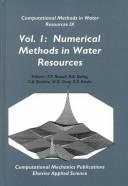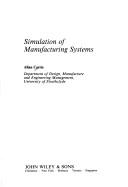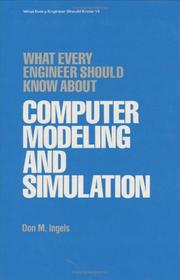| Listing 1 - 10 of 73 | << page >> |
Sort by
|
Book
ISBN: 0911801103 Year: 1986 Publisher: Ghent San Diego SCS Europe Society for computer simulation
Abstract | Keywords | Export | Availability | Bookmark
 Loading...
Loading...Choose an application
- Reference Manager
- EndNote
- RefWorks (Direct export to RefWorks)
Dissertation
ISBN: 9789059891418 9059891414 Year: 2006 Publisher: Gent Universiteit Gent. Faculteit Bio-Ingenieurswetenschappen
Abstract | Keywords | Export | Availability | Bookmark
 Loading...
Loading...Choose an application
- Reference Manager
- EndNote
- RefWorks (Direct export to RefWorks)
631.432.2 --- 681.3*I63 --- Soil moisture --- Applications (Simulation and modeling) --- Theses --- 681.3*I63 Applications (Simulation and modeling) --- 631.432.2 Soil moisture --- Assimilation
Dissertation
ISBN: 9789086497409 Year: 2014 Publisher: Leuven Katholieke Universiteit Leuven
Abstract | Keywords | Export | Availability | Bookmark
 Loading...
Loading...Choose an application
- Reference Manager
- EndNote
- RefWorks (Direct export to RefWorks)
I. Study of data reduction and analysis of ACS/HST in UV line and continuum data for low-mass accreting T Tauri stars.II. Definition and implementation of a global software simulation package to assess and evaluate the performances of various detectors (CCD, CMOS,...) for high-precision measurements of various types of stars, applicable to both space and ground-based instrumentation. Application of this tool to the science detectors of the ESA M3 selected mission PLATO.

ISBN: 1851667911 1853121975 1562521233 1851668713 185312169X 1562520989 1851668705 1853121983 1562521241 Year: 1992 Volume: vol. 1 Publisher: Southampton Boston London New York Computational Mechanics Publications Elsevier Applied Science
Abstract | Keywords | Export | Availability | Bookmark
 Loading...
Loading...Choose an application
- Reference Manager
- EndNote
- RefWorks (Direct export to RefWorks)
556.048 --- 681.3*I63 --- Hydrological computation. Including : coefficients --- Applications (Simulation and modeling) --- 681.3*I63 Applications (Simulation and modeling) --- Hydrology --- 631.432 --- 631.432 Groundwater. Agricultural hydrology --- Groundwater. Agricultural hydrology --- Data processing --- Mathematical models --- Conferences - Meetings --- Congresses --- Statistical methods
Dissertation
ISBN: 9789059892231 Year: 2008 Publisher: Gent Universiteit Gent. Faculteit Bio-Ingenieurswetenschappen
Abstract | Keywords | Export | Availability | Bookmark
 Loading...
Loading...Choose an application
- Reference Manager
- EndNote
- RefWorks (Direct export to RefWorks)
Modèle --- Models --- Application des ordinateurs --- computer applications --- Logiciel --- Computer software --- environment --- 504 --- 681.3*I63 --- Environment. Environmental science --- Applications (Simulation and modeling) --- Theses --- 681.3*I63 Applications (Simulation and modeling) --- 504 Environment. Environmental science
Dissertation
ISBN: 9789088263446 Year: 2014 Volume: 1158 Publisher: Leuven Katholieke Universiteit Leuven
Abstract | Keywords | Export | Availability | Bookmark
 Loading...
Loading...Choose an application
- Reference Manager
- EndNote
- RefWorks (Direct export to RefWorks)
The fact that production of pome fruits is both season and location dependent calls for preservation methods to maintain the quality of the produce after harvest. The principal method to preserve pome fruit is postharvest storage in cool rooms under Controlled Atmosphere (CA) or Ultra Low Oxygen (ULO) conditions. These methods are based on empirical trials to determine optimum storage conditions for a specific cultivar in terms of temperature, oxygen and carbon dioxide concentration and relative humidity. Improved understanding of the underlying fruit physiology in relation to the gas and water exchange processes during storage will assist in improving postharvest quality and reducing the occurrence of storage disorders. Both experimental and modeling approaches have been followed to investigate the relationship between the gas concentration, gas diffusion, respiration and physiological disorders in apple and pear. Experimental approaches are, however, costly, tiresome and time consuming. Moreover, it is difficult to investigate the time course of the physiological disorders experimentally because of the lack of non-destructive techniques to measure the internal gas concentration in the fruit. Alternatively, mathematical models can be used to study gas and water exchange. They are usually based on the continuum hypothesis where the fruit is considered as a material with transport properties that are independent of the spatial scale. However, unlike the traditional engineering materials fruit tissue has a complex fine structure. The cellular architecture is believed to determine to a large extent the biophysical processes in the fruit. The continuum hypothesis does not hold in this case and a multiscale approach is required in which the model parameters of the model that operates at the macroscale the scale of interest are obtained from simulations with a microscale model that incorporates the actual microstructure of the fruit. For the latter, microscale geometric models of the fruit are required. Pome fruit tissue microscale geometry generators exist today but are based on digitized 2D or 3D images of the cellular architecture. Therefore, although these algorithms generate representative geometries of the tissues, they require experimental input in terms of microscopic images. These approaches need complex image acquisition procedures and expensive infrastructures such as synchrotron radiation sources. Also, they do not allow to parameterize the microscale geometry to, for example, investigate the effect of cell size or shape on the transport properties in a systematic way. The main objective of this dissertation was to develop virtual microscale fruit tissue generators (algorithms) that generate statistically and spatially equivalent virtual tissue microstructures resolving the cell symplast, cell wall and intercellular air spaces in both 2D and 3D and interface them to finite element and/or finite volume codes. To achieve this, we have developed virtual tissue generators that are based on cell growth modeling bytaking into account cell biomechanics. The generators are initiated from a random Voronoi tessellation and growth biomechanics is applied to the tessellation which results in a virtual tissue that has equivalent geometrical properties as that of real tissues obtained from microscopic or synchrotron microtomography images. In a further extension we have also developed a cell division algorithm which is based on cell biomechanics and that is capable of mimicking both symmetric cell division and asymmetric cell division with different degree of anisotropic growth. The cell division algorithm can be used instead of the Voronoi tessellation as an input for the expansive growth models. Initial tessellations obtained from the cell division algorithm will have more realistic representation of the cells than the Voronoi tessellations. The geometric models can be used to carry out in silico simulations to determine transport properties to be used in multiscale framework of gas and moisture exchange studies in pome fruits. This approach helps to include more geometrical details and fewer assumptions than the classical continuum modeling approach, while requiring less computer time compared to solving governing model equations at the resolution of the microscale.

ISBN: 0080440150 0080440282 9780080440286 9786611046088 1281046086 0080532101 9780080440156 9780080532103 Year: 2006 Volume: 21 Publisher: Amsterdam: Elsevier,
Abstract | Keywords | Export | Availability | Bookmark
 Loading...
Loading...Choose an application
- Reference Manager
- EndNote
- RefWorks (Direct export to RefWorks)
This is a thoroughly revised and updated edition of an authoritative introduction to ecological modelling. Sven Erik Jørgensen, Editor-in-Chief of the journal Ecological Modelling, and Giuseppe Bendoricchio, Professor of Environmental Modelling at the University of Padova, Italy, offer compelling insights into the subject. This volume explains the concepts and processes involved in ecological modelling, presents the latest developments in the field and provides readers with the tools to construct their own models. The Third Edition features: A detailed discussion and step-by-s
Ecology --- Simulation methods. --- 681.3*I63 --- 574 --- 574 General ecology. Biocoenology. Hydrobiology. Biogeography --- General ecology. Biocoenology. Hydrobiology. Biogeography --- 681.3*I63 Applications (Simulation and modeling) --- Applications (Simulation and modeling) --- Simulation methods --- Ecology - Simulation methods --- ECOLOGY --- SIMULATION METHODS

ISBN: 0471915742 Year: 1992 Publisher: New York Wiley
Abstract | Keywords | Export | Availability | Bookmark
 Loading...
Loading...Choose an application
- Reference Manager
- EndNote
- RefWorks (Direct export to RefWorks)
Planning (firm) --- 681.3*I63 --- fms --- produktiesimulatie --- Applications (Simulation and modeling) --- 681.3*I63 Applications (Simulation and modeling) --- Manufacturing processes --- 519.87 --- 519.87 Mathematical models for operational research --- Mathematical models for operational research --- Computer simulation
Book
ISBN: 0471934623 9780471934622 Year: 1992 Publisher: Chichester: Wiley,
Abstract | Keywords | Export | Availability | Bookmark
 Loading...
Loading...Choose an application
- Reference Manager
- EndNote
- RefWorks (Direct export to RefWorks)
Management science --- Computer simulation. --- 519.876 --- -681.3*I63 --- Quantitative business analysis --- Management --- Problem solving --- Operations research --- Statistical decision --- Theory of large systems --- Computer simulation --- Applications (Simulation and modeling) --- 681.3*I63 Applications (Simulation and modeling) --- 519.876 Theory of large systems --- 681.3*I63 --- Management science - Computer simulation.

ISBN: 0824774442 9780824774448 Year: 1985 Volume: 15 Publisher: New York (N.Y.): Dekker,
Abstract | Keywords | Export | Availability | Bookmark
 Loading...
Loading...Choose an application
- Reference Manager
- EndNote
- RefWorks (Direct export to RefWorks)
Engineering --- Digital computer simulation --- Mathematical models --- -681.3*I63 --- 519.876.5 --- 519.86 --- Construction --- Industrial arts --- Technology --- Digital simulation --- Computer simulation --- Applications (Simulation and modeling) --- Numerical imitation of systems. Simulation --- Theory of economic-mathematical models --- 519.86 Theory of economic-mathematical models --- 519.876.5 Numerical imitation of systems. Simulation --- 681.3*I63 Applications (Simulation and modeling) --- 681.3*I63 --- Digital computer simulation. --- Mathematical models. --- Engineering - Mathematical models
| Listing 1 - 10 of 73 | << page >> |
Sort by
|

 Search
Search Feedback
Feedback About UniCat
About UniCat  Help
Help News
News